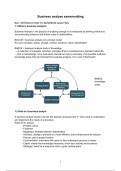Samenvatting
Summary - Business analysis - Professor De Weerdt - Score: 17/20
- Vak
- Instelling
In deze samenvatting vind je alle belangrijke begrippen, aspecten en principes van het vak Business Analyse. Het covert BA1-BA4 en BPM1-BPM13, gegeven door professor Jochen De Weerdt. Door deze samenvatting heb ik een 17/20 gehaald in de eerste zit op het examen. Het is geschreven in het Engels. ...
[Meer zien]




